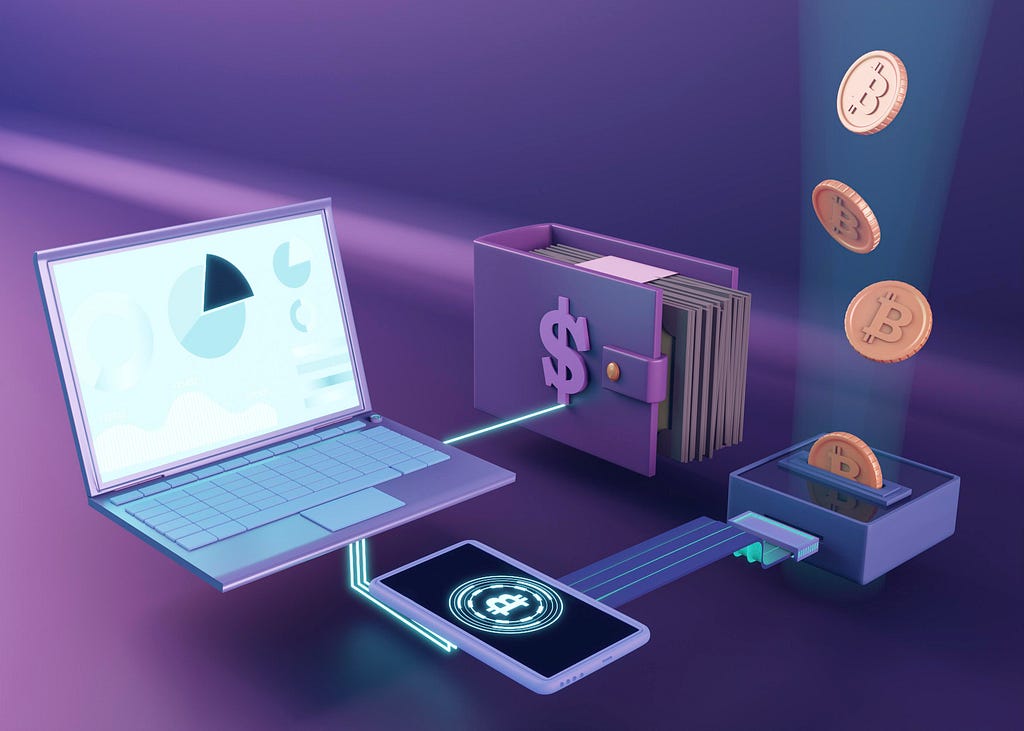
The world of digital assets and decentralized applications is expanding rapidly. At the heart of this growth are Web3 wallets, which are not just tools for storing cryptocurrencies, but essential gateways to the entire ecosystem of blockchain-based services. For businesses and clients exploring the potential of blockchain, understanding how Web3 wallets work and why they matter is crucial.
What Are Web3 Wallets?
Web3 wallets are digital wallets designed for interacting with decentralized applications (dApps) built on blockchain technology. Unlike traditional wallets that simply store cash or cards, Web3 wallets manage digital assets such as cryptocurrencies, NFTs, and tokens, while also providing access to a wide range of blockchain services.
Key Components of Web3 Wallets
- Public Wallet Address: Functions like an email address for receiving assets.
- Password: Used to access the wallet app, not to be confused with the private key.
- Seed Phrase: A series of 12–24 words that acts as a backup for wallet recovery.
- Private Key: A unique string that authorizes transactions and proves ownership.
How Web3 Wallets Work
When you create a Web3 wallet, the app generates a public address and a private key. The public address is shared to receive assets, while the private key is kept secret to sign transactions. Here’s a typical transaction flow:
- Initiate Transaction: The user requests an action (sending crypto, interacting with a dApp).
- Create Digital Message: The wallet prepares a message with transaction details.
- Sign Transaction: The private key signs the message, confirming authorization.
- Broadcast: The signed transaction is sent to the blockchain network.
- Validation: Network validators check the transaction.
- Confirmation: The transaction is permanently recorded on the blockchain.
This process happens in seconds or minutes, making it much faster than most traditional financial transactions.
Key Features of Web3 Wallets
Web3 wallets offer a range of features that make them indispensable for anyone engaging with blockchain technology:
- Multi-Chain Support: Manage assets across multiple blockchains like Ethereum, Solana, and Polygon from a single interface.
- Browser and App Integration: Available as browser extensions, mobile apps, or hardware devices for different user preferences.
- Token and NFT Management: Store, send, and receive various cryptocurrencies and NFTs, with visual displays for easy management.
- Real-Time Interaction: Instantly connect to dApps, approve transactions, and interact with smart contracts directly from the wallet.
Web3 Wallets vs. Traditional Wallets

Web3 wallets stand out by giving users direct control, supporting a wide range of assets, and enabling interaction with decentralized services.
Benefits for Businesses and Users
Direct Access to Decentralized Services
Web3 wallets allow users to connect directly to DeFi platforms, NFT marketplaces, and other dApps without intermediaries. This opens up new business models and opportunities for innovation.
User Ownership and Privacy
With Web3 wallets, users hold their private keys, meaning they have full ownership of their assets. Transactions can be conducted without revealing personal information, reducing the risk of identity theft.
Interoperability and Flexibility
Most Web3 wallets support multiple blockchains, making it easy to manage diverse assets and interact with various protocols from one place. This is especially valuable for businesses operating in global markets or dealing with multiple cryptocurrencies.
Security Advantages
The use of cryptographic keys and decentralized infrastructure makes Web3 wallets highly secure against hacking and centralized failures. Users are responsible for their own security, which, when managed properly, adds a robust layer of protection.
Types of Web3 Wallets
Software Wallets
- Browser Extensions: Popular options include MetaMask and Phantom, which integrate directly with web browsers for easy dApp access.
- Mobile Apps: Wallets like Trust Wallet and Rainbow offer on-the-go management and interaction with dApps.
Hardware Wallets
Physical devices like Ledger and Trezor store private keys offline, providing extra security for large holdings.
Custodial vs. Non-Custodial
- Non-Custodial: Users control their private keys (most Web3 wallets).
- Custodial: Third parties manage keys, offering convenience but less control.
Web3 Wallets and Decentralized Finance (DeFi)
One of the most significant developments in the blockchain space is decentralized finance (DeFi). Web3 wallets are the entry point for users to access DeFi protocols, enabling activities such as:
- Lending and borrowing assets
- Trading on decentralized exchanges
- Providing liquidity to pools
- Yield farming and staking
By integrating directly with DeFi platforms, Web3 wallets simplify complex processes and make blockchain finance accessible to a broader audience.
NFTs and Digital Identity
Web3 wallets are also crucial for managing NFTs and establishing digital identities. They allow users to:
- Mint, buy, and sell NFTs on various marketplaces
- Prove ownership of digital collectibles
- Use wallet addresses as digital identities for authentication across dApps
Security Practices for Web3 Wallets
While Web3 wallets offer strong security features, users must follow best practices to protect their assets:
- Safeguard Seed Phrases: Store them offline in a secure location.
- Never Share Private Keys: Keep them confidential at all times.
- Use Hardware Wallets for Large Holdings: Offline storage reduces exposure to online threats.
- Stay Updated: Use the latest wallet versions and security patches
Challenges and Considerations
User Experience
While Web3 wallets have become more user-friendly, there is still a learning curve for new users. Businesses targeting mainstream adoption need to focus on intuitive interfaces and clear guidance.
Regulatory Compliance
As blockchain adoption grows, regulatory requirements are evolving. Businesses must stay informed about compliance standards in different jurisdictions, especially when offering wallet services.
Interoperability
Supporting multiple blockchains and tokens can be complex. Choosing the right wallet architecture and development partner is essential for seamless integration.
Future Trends in Web3 Wallet Development
The Web3 wallet space is evolving rapidly, with several trends shaping its future:
- Deeper Integration with DeFi and dApps: Wallets will increasingly offer built-in access to a wide range of decentralized services, reducing the need for multiple platforms.
- Multi-Chain and Cross-Chain Capabilities: As more blockchains emerge, wallets that support cross-chain transactions and asset management will become standard.
- Enhanced User Experience: Expect more intuitive interfaces, educational resources, and onboarding tools to make blockchain accessible to everyone.
- Advanced Security Features: Biometric authentication, multi-signature wallets, and social recovery mechanisms will become more common.
- Decentralized Identity Solutions: Wallets will play a key role in digital identity management, enabling secure authentication and reputation systems across dApps.
Why Businesses Should Pay Attention
For businesses and potential clients, Web3 wallets are more than just a technical tool-they are a gateway to the future of digital commerce and finance. Whether you’re building a new dApp, launching a token, or exploring decentralized finance, integrating robust wallet solutions is essential.
Opportunities for Businesses
- Direct Customer Engagement: Web3 wallets enable businesses to interact with customers without intermediaries, opening up possibilities for loyalty programs, tokenized assets, and more.
- Global Reach: With support for multiple blockchains and currencies, businesses can serve a worldwide audience.
- Innovation in Payments: Instant, borderless transactions reduce costs and friction compared to traditional payment systems.
- Participation in Decentralized Governance: Many platforms allow wallet holders to vote on key decisions, giving businesses a voice in ecosystem development.
Selecting the Right Web3 Wallets Development Partner
Choosing an experienced Web3 Wallets Development Company is crucial for building secure, scalable, and user-friendly wallet solutions. The right partner will understand the nuances of blockchain technology, security best practices, and regulatory requirements.
Web3 Wallets in Crypto Exchange Development
Web3 wallets are central to modern Crypto Exchange Development. They facilitate secure deposits, withdrawals, and trading of digital assets, while also enabling users to interact with DeFi protocols and other blockchain services directly from the exchange platform.
Web3 Wallets and Blockchain Development
As blockchain Development matures, Web3 wallets will continue to play a vital role in connecting users to decentralized networks, supporting new use cases, and driving adoption across industries.
Conclusion
Web3 wallets are at the core of the ongoing evolution in crypto and blockchain interactions. They offer direct access to decentralized services, give users control over their assets, and support a wide range of digital activities from DeFi to NFTs. For businesses and clients looking to participate in this ecosystem, understanding and adopting Web3 wallet solutions is a strategic move.
Take the Next Step
Ready to explore the possibilities of Web3 wallets for your business? Partner with Codezeros-a leading Web3 Wallets Development Company-to build secure, scalable, and innovative wallet solutions tailored to your needs. Contact us today to start your journey into the decentralized future.
Thank you for being a part of the community
Before you go:
- Be sure to clap and follow the writer ️👏️️
- Follow us: X | LinkedIn | YouTube | Newsletter | Podcast | Differ | Twitch
- Start your own free AI-powered blog on Differ 🚀
- Join our content creators community on Discord 🧑🏻💻
- For more content, visit plainenglish.io + stackademic.com
How Web3 Wallets Are Changing Crypto and Blockchain Interactions was originally published in Artificial Intelligence in Plain English on Medium, where people are continuing the conversation by highlighting and responding to this story.







